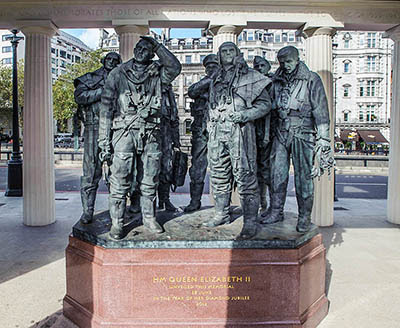March 12, 1945 - Arrival at Dulag Luft
After a three-day journey, Douglas Hicks, Gerard Kelleher, Gordon Nicol and David Yemen arrived at Dulag Luft’s interrogation centre at Oberursel.
Dulag Luft (short for Durchgangslager der Luftwaffe or ‘Luftwaffe base camp’) was an air force transit camp through which nearly all air force personnel captured by the Germans were sent. The camp, administered by the German Luftwaffe and the Abwehr, was composed of three facilities: The interrogation centre at Oberursel; a hospital site at Hohemark and the transit camp at Wetzlar.
Dulag Luft (short for Durchgangslager der Luftwaffe or ‘Luftwaffe base camp’) was an air force transit camp through which nearly all air force personnel captured by the Germans were sent. The camp, administered by the German Luftwaffe and the Abwehr, was composed of three facilities: The interrogation centre at Oberursel; a hospital site at Hohemark and the transit camp at Wetzlar.
The Interrogation Centre at Oberursel contained 200 compact solitary confinement cells, each with a cot, table, a chair and an electric bell, which prisoners could use to summon a guard. The entire camp was surrounded by a barbed wire fence, but there was no guard tower.
On arrival at the interrogation centre, prisoners were undressed and their clothing would be searched. After being placed in a cell, the prisoner would be visited by a reception officer who would try to get the prisoner to answer all of the questions on a bogus Red Cross form. This form contained basic details such as name and rank, plus more sensitive information such as Squadron and aircraft details - questions prohibited under the Geneva Convention. Towards the end of the war, most prisoners had heard of the Red Cross form ruse and knew better than to answer anything further than name, rank and serial number.
The reception officer would pass all acquired information along with an assessment of the character of the prisoner to the interrogator.
Interrogations were sometimes held in cells but more often in the interrogator’s office and were generally short, since most air crew would have little information of note. In the case of a pilot or someone who might have access to more sensitive information, the interrogation could go on for several days. The interrogation officers would compile all collected information which would then be forwarded to German Air Force Operations.
Allied POWs could be subjected to threats, withheld rations or a seriously overheated cell, but in general, the interrogators at Dulag Luft considered a ‘friendly approach’ to be the most productive.
While at the interrogation centre, food rations were bleak… 2 slices of black bread and jam with coffee substitue in the morning, watery soup at midday and 2 slices of bread at night. No Red Cross parcels were issued.
Records indicate Hicks was released to the main camp at Wetzlar the following day and it is likely his companions Kelleher, Nicol and Yemen would have been moved at the same time.

Comments
Post a Comment